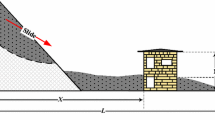Abstract
The Missouri Rock Fall Hazard Rating System (MORFH RS) was recently developed for the State of Missouri. It is a system that separates the risk of failure from the consequences of failure factors, thus allowing better assessment of the hazards of rock falls. Efficiency is gained by video logging of highway rock cuts from vehicles moving at highway speeds, pre-screening of rock cuts from video images, making some of the measurements needed for the rating system on digital images, and using GPS receivers to collect field data and GIS to organize all the data. This paper describes the rationale behind the parameters selected for the system using factor analysis and other methods and the verification of the system through sensitivity studies and multiple rater tests. Simulations of remediation techniques were applied to recognize the most effective methods for remediation.
Résumé
Le système d’évaluation de l’aléa de chute de blocs dans le Missouri (MORFH SR) a été récemment développé pour l’état du Missouri. Ce système distingue le risque de rupture des conséquences des facteurs de rupture, permettant ainsi une meilleure évaluation des aléas de chute de blocs. L’efficacité du système réside dans l’utilisation de panoramas vidéo des déblais rocheux d’autoroute réalisés à partir de véhicules se déplaçant à grande vitesse, la réalisation de pré-enregistrements des déblais rocheux à partir d’images vidéo, l’acquisition de mesures nécessaires au système d’évaluation à partir d’images numériques et l’utilisation de capteurs GPS pour rassembler les données de terrain et d’un système SIG pour traiter ces données. Cet article décrit le raisonnement développé à partir des paramètres sélectionnés pour le système d’évaluation, utilisant l’analyse factorielle et d’autres méthodes et vérifiant le système à travers des études de sensibilité et de multiples tests. Des simulations de techniques de limitation des risques ont été réalisées pour identifier les méthodes les plus efficaces.













Similar content being viewed by others
References
Afifi AA, Clark V (1996) Computer-aided multivariate statistics, 3rd edn. Chapman & Hall, New York, 455 pp
Afifi AA, Clark V, May S (2004) Computer-aided multivariate statistics, 4th edn. Chapman & Hall, New York, 489 pp
Bellamy D, Bateman V, Drumm E, Dunne W, Vandewater C, Mauldon M, Rose B (2003) Electronic data collection for rockfall analysis. Transp Res Rec 1821:97–103. doi:10.3141/1821-12
Fish M, Lane R (2002) Linking New Hampshire’s rock cut management system with a geographic information system. Transp Res Rec 1786:51–59. doi:10.3141/1786-06
Franklin JA, Dusseault MB (1989) Rock engineering. McGraw-Hill, New York, 600 pp
Franklin JA, Senior SA (1987) Outline of RHRON, the Ontario rockfall hazard rating system. In: Proceedings international symposium on engineering geology and the environment, Athens, Greece, pp 647–656
Geological Society Engineering Group Working Party (1995) The description and classification of weathered rocks for engineering purposes. Q J Eng Geol Hydrol 28:207–242. doi:10.1144/GSL.QJEGH.1995.028.P3.02
Hadjin DJ (2002) New York State Department of Transportation rock slope rating procedure and rockfall assessment. Transp Res Rec 1786:60–68. doi:10.3141/1786-07
Ho CL, Norton SS (1991) Development of an unstable slope management system. Washington State Department of Transportation Report WA-RD 270.1
Hoek E (2000) Practical rock engineering. Rocscience, Toronto, Canada, 313 pp
ISRM (1978) Suggested methods quantitative description of discontinuities in rock masses. Int J Rock Mech Min Sci Geomech Abstr 15:319–368
Jones CL, Higgins JD, Andrew RD (2000) Colorado rockfall simulation program, version 4.0: Colorado Department of Transportation, Denver, CO, 127 pp
Maerz NH, Youssef AM, Fennessey TW (2005) New risk-consequence rock fall hazard rating system for Missouri highways using digital image analysis. Environ Eng Geosci V.XI(3):229–249. doi:10.2113/11.3.229
MODOT (2000) Traffic volume and commercial vehicle counts 2000
Pack RT, Boie K (2002) Utah rockfall hazard inventory—phase I, Utah Department of Transportation, Research Division, Report No. UT-03.01
Pierson LA, Van Vickle R (1993) Rockfall hazard rating system—participants’ manual: FHWA report:—FHWA-SA-93-057, 102 pp
Pierson LA, Gullixson CF, Chassie RG (2001) Rockfall catchment area design guide. Final report SPR-3 (032), 92 pp
Ritchie AM (1963) Evaluation of rockfall and its control. Highway Res Rec 17:13–28
Saltelli A (2002) Sensitivity analysis for importance sampling. Risk Anal 22(3):579–590
Saltelli A, Chan K, Scott EM (2000) Sensitivity analysis. Wiley, West Sussex, England, 475 pp
Vandewater CJ, Dunne WM, Mauldon M, Drumm EC, Bateman V (2005) Classifying and assessing the geologic contribution to rockfall hazard. Environ Eng Geosci 11(2):141–154. doi:10.2113/11.2.141
Hock E, Bray JW (1981) Rock slope engineering, 3rd edn. Institution of Mining and Metallurgy, London, 402 pp
Youssef A, Maerz NH, Qinfang X (2007) RockSee: video image measurements of physical features to aid in highway rock cut characterization. Comput Geosci 33(3):437–444. doi:10.1016/j.cageo.2006.08.005
Acknowledgments
The authors would like to acknowledge the Missouri Department of Transportation (MODOT) for funding this research. They would especially like to thank Mike Fritz, Ray Purvis and Rob Lauer of MODOT for their help in providing guidance for this project. They would like to thank the University of Missouri System Research Board for the original seed funding of this research, especially the development of the RockSee program. The authors would also like to thank the raters who helped in verifying the rating system.
Author information
Authors and Affiliations
Corresponding author
Rights and permissions
About this article
Cite this article
Youssef, A.M., Maerz, N.H. Development, justification, and verification of a rock fall hazard rating system. Bull Eng Geol Environ 71, 171–186 (2012). https://doi.org/10.1007/s10064-010-0339-2
Received:
Accepted:
Published:
Issue Date:
DOI: https://doi.org/10.1007/s10064-010-0339-2




